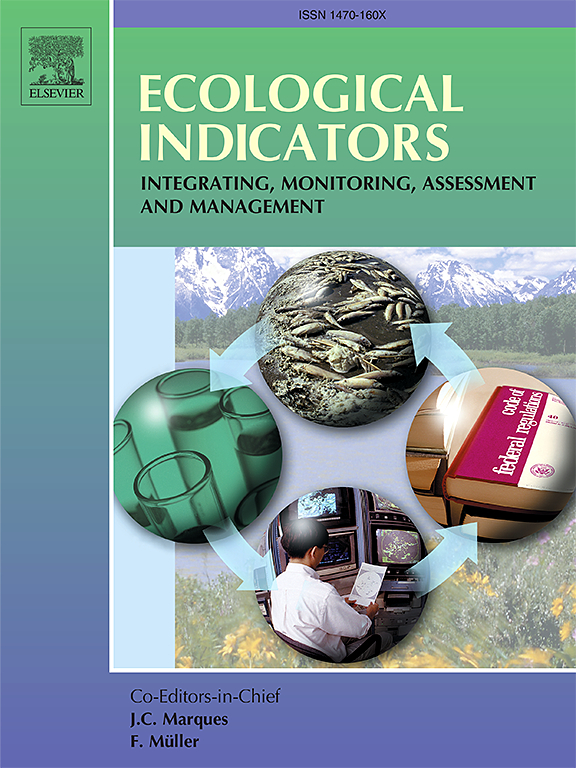A novel evapotranspiration downscaling approach based on dynamic sensitive parameters and deep learning in the grassland lacking historical measurements
IF 7
2区 环境科学与生态学
Q1 ENVIRONMENTAL SCIENCES
引用次数: 0
Abstract
To address the challenges of ecohydrological modeling in data-scarce semi-arid steppe basins, this study developed the Distributed Dynamic Process Model (DDPM), integrating multi-source data and a novel evapotranspiration (ET) module enhanced by dynamic sensitivity parameters and deep learning. By leveraging meteorological, soil, vegetation, and remote sensing data, we analyzed the ET dynamics of ten representative vegetation communities in the Xilin River Basin (XRB) from 1980 to 2018. Key findings include: (1) A Naive Bayesian model, utilizing temperature and surface reflectance, achieved high snow cover detection accuracy (>0.95); (2) Incorporating dynamic sensitivity parameters significantly improved ET simulation accuracy (R2 increased from 0.816 to 0.941, NSE from 0.583 to 0.769); (3) Multi-scale validation (annual, seasonal, daily, and 3-hour) against the Penman-Monteith model and Bowen Ratio-Energy Balance method confirmed the model’s robustness, particularly at the 3-hour scale. These results highlight vegetation-specific ET responses to climate change and underscore the need for refined dynamic parameterization and algorithmic structures. The DDPM framework provides a robust approach for ecohydrological modeling in data-scarce regions, offering insights for adaptive water resource management and ecological restoration.
基于动态敏感参数和深度学习的草地蒸散发降尺度方法
为了解决数据稀缺的半干旱草原流域生态水文建模面临的挑战,本研究开发了分布式动态过程模型(DDPM),该模型集成了多源数据和一个新的蒸散发(ET)模块,该模块通过动态敏感性参数和深度学习增强。利用气象、土壤、植被和遥感资料,分析了1980 - 2018年锡林河流域10个代表性植被群落的ET动态。主要发现包括:(1)利用温度和地表反射率的朴素贝叶斯模型实现了较高的积雪探测精度(>0.95);(2)纳入动态灵敏度参数显著提高了ET模拟精度(R2从0.816提高到0.941,NSE从0.583提高到0.769);(3)针对Penman-Monteith模型和Bowen Ratio-Energy Balance方法的多尺度验证(年、季节、日和3小时)证实了模型的稳健性,特别是在3小时尺度上。这些结果强调了植被对气候变化的特异性ET响应,并强调了改进动态参数化和算法结构的必要性。DDPM框架为数据稀缺地区的生态水文建模提供了一个强大的方法,为适应性水资源管理和生态恢复提供了见解。
本文章由计算机程序翻译,如有差异,请以英文原文为准。
求助全文
约1分钟内获得全文
求助全文
来源期刊

Ecological Indicators
环境科学-环境科学
CiteScore
11.80
自引率
8.70%
发文量
1163
审稿时长
78 days
期刊介绍:
The ultimate aim of Ecological Indicators is to integrate the monitoring and assessment of ecological and environmental indicators with management practices. The journal provides a forum for the discussion of the applied scientific development and review of traditional indicator approaches as well as for theoretical, modelling and quantitative applications such as index development. Research into the following areas will be published.
• All aspects of ecological and environmental indicators and indices.
• New indicators, and new approaches and methods for indicator development, testing and use.
• Development and modelling of indices, e.g. application of indicator suites across multiple scales and resources.
• Analysis and research of resource, system- and scale-specific indicators.
• Methods for integration of social and other valuation metrics for the production of scientifically rigorous and politically-relevant assessments using indicator-based monitoring and assessment programs.
• How research indicators can be transformed into direct application for management purposes.
• Broader assessment objectives and methods, e.g. biodiversity, biological integrity, and sustainability, through the use of indicators.
• Resource-specific indicators such as landscape, agroecosystems, forests, wetlands, etc.
 求助内容:
求助内容: 应助结果提醒方式:
应助结果提醒方式:


